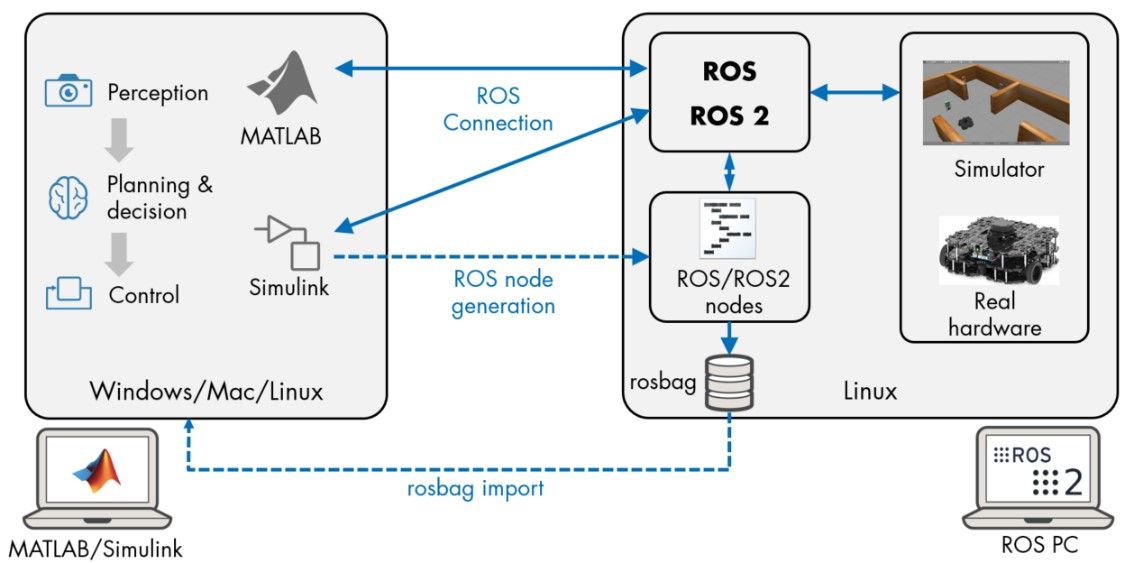ROS与OpenCV:机器人视觉中的图像分割技术,让机器人理解复杂场景
发布时间: 2024-08-09 07:41:07 阅读量: 83 订阅数: 27 


(源码)基于ROS和OpenCV的机器人视觉系统项目Geen Moer Aan.zip

# 1. 机器人视觉概述
**1.1 机器人视觉的定义和意义**
机器人视觉是计算机科学的一个分支,它赋予机器人“视觉”能力,使它们能够感知和理解周围环境。它涉及从图像或视频中提取有意义的信息,从而为机器人提供决策和行动所需的洞察力。
**1.2 机器人视觉的应用领域**
机器人视觉在广泛的领域中有着重要的应用,包括:
* **工业自动化:**机器人在制造业中执行任务,例如装配、检查和包装。
* **服务机器人:**机器人用于执行服务任务,例如清洁、送货和客户服务。
* **医疗保健:**机器人辅助手术、诊断和康复。
* **无人驾驶:**机器人视觉使自动驾驶汽车能够感知道路环境并做出安全决策。
# 2. 图像分割技术在机器人视觉中的应用
图像分割是计算机视觉中一项基本技术,其目的是将图像分解为具有相似特征(如颜色、纹理、形状等)的不同区域。在机器人视觉中,图像分割对于目标检测、环境感知和建模等任务至关重要。
### 2.1 图像分割的基本概念和方法
#### 2.1.1 分割算法的分类
图像分割算法可分为基于区域的算法和基于边缘的算法。
* **基于区域的算法**将图像中的像素聚类为具有相似特征的区域。常见的算法包括:
* 区域增长
* 分水岭算法
* 均值漂移算法
* **基于边缘的算法**检测图像中的边缘,然后将边缘连接起来形成区域。常见的算法包括:
* Canny边缘检测
* Sobel边缘检测
* Laplacian边缘检测
#### 2.1.2 常见的分割算法
在机器人视觉中,常用的图像分割算法包括:
* **阈值分割:**根据像素的灰度值将图像分割为二值图像。
* **K-Means聚类:**将像素聚类为K个簇,每个簇对应一个分割区域。
* **图割:**将图像表示为图,并使用图论算法找到最优分割。
* **深度学习:**使用卷积神经网络(CNN)自动学习图像特征并进行分割。
### 2.2 图像分割的实践应用
#### 2.2.1 目标检测和识别
图像分割在目标检测和识别中发挥着至关重要的作用。通过分割图像,可以将感兴趣的对象从背景中分离出来,从而提高检测和识别的准确性。
#### 2.2.2 环境感知和建模
在机器人视觉中,图像分割用于感知和建模周围环境。通过分割图像,机器人可以识别障碍物、墙壁、家具等物体,从而建立对环境的理解。
```python
import cv2
import numpy as np
# 图像读取
image = cv2.imread('image.jpg')
# 灰度转换
gray = cv2.cvtColor(image, cv2.COLOR_BGR2GRAY)
# 阈值分割
_, thresh = cv2.threshold(gray, 127, 255, cv2.THRESH_BINARY)
# 轮廓检测
contours, _ = cv2.findContours(thresh, cv2.RETR_EXTERNAL, cv2.CHAIN_APPROX_SIMPLE)
# 绘制轮廓
cv2.drawContours(image, contours, -1, (0, 255, 0), 2)
# 显示结果
cv2.imshow('Segmented Image', image)
cv2.waitKey(0)
cv2.destroyAllWindows()
```
**代码逻辑分析:**
* `cv2.imread()`:读取图像。
* `cv2.cvtColor()`:将图像转换为灰度图像。
* `cv2.threshold()`:使用阈值分割将灰度图像转换为二值图像。
* `cv2.findContours()`:检测二值图像中的轮廓。
* `cv2.drawContours()`:在原始图像上绘制轮廓。
* `cv2.imshow()`:显示分割后的图像。
# 3.1 ROS(机器人操作系统)概述
#### 3.1.1 ROS的架构和功能
ROS(Robot Operating System,机器人操作系统)是一个开源的机器人软件框架,它提供了一套用于构建机器人应用程序的工具和库。ROS采用分布式架构,由以下主要组件组成:
- **ROS主节点(ROS Master):** 负责管理ROS系统中的节点和话题,并提供名称服务和参数服务器。
- **节点(Node):** 独立的进程,负责执行特定任务,例如传感器数据采集、图像处理或运动控制。
- **话题(Topic):** 用于节点之间发布和订阅消息的命名管道。
- **消息(Message):** 在话题上发布和订阅的数据结构,包含特定类型的数据(例如传感器数据、控制命令)。
- **服务(Service):** 用于节点之间进行请求-响应交互的机制。
- **包(Package):** 组织相关代码和资源的集合,例如节点、消息类型和服务。
#### 3.1.2 ROS的应用领域
ROS广泛应用于各种机器人领域,包括:
- 移动机器人导航和控制
- 感知和环境建模
- 操作和操纵
- 人机交互
- 仿真和测试
ROS的模块化设计和丰富的生态系统使其成为构建复杂机器人系统的理想平台。
# 4. ROS与OpenCV集成
##
0
0





